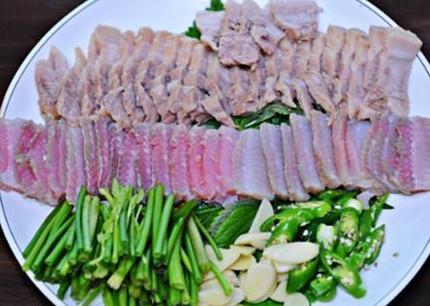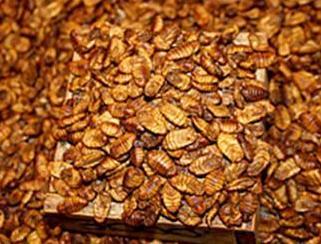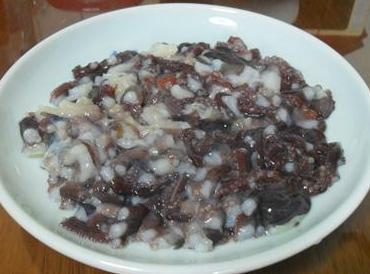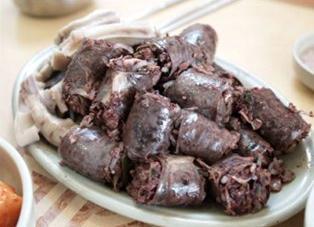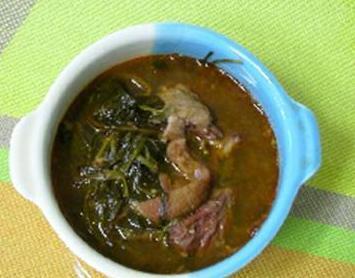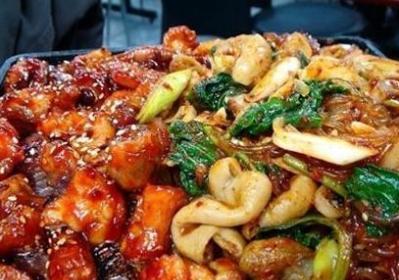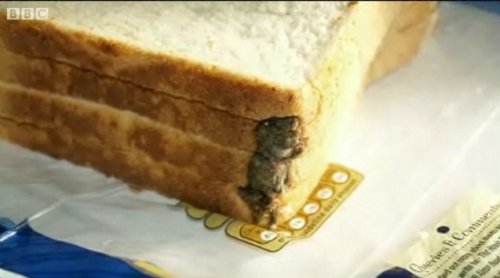Kimbab is a popular Korean fast food made from steamed white rice and various ingredients, rolled in laver and served cold in bite-size slices. Kimbab is often eaten during picnics or outdoor events, or as a light lunch, served with danmuji(pickled radish or kimchi).

5 roasted sea laver sheets (nori in Japanese)
2 eggs
1 carrot
yellow pickled radish
ham (or sausage)
1 cucumber
salt
sesame oil
cooked rice
1. Whip eggs well. Fry the egg in a pan and make the egg stick by rolling it.
2. Cut carrot and cucumber into long thin strips. Cook carrot strips on a skillet with oil. Soak cucumber in salt and vinegar water for 20 minutes.
3. Cut ham or sausage into long thin strips and cook them in a pan.
4. Cut yellow radish into long thin strips.
5. Add 1T of sesame oil and 2 sprinkles of salt to the rice and mix them well.
6. Place a sheet of sea laver over a bamboo mat. Spread rice thinly, but covering well, up to 2/3 of the sea laver. (leave 1/3 of the space.) Place strips (carrot, cucumber, egg, yellow pickled radish..) in the middle of the spread rice, and place other things within 1/3 of the length of laver.
7. Roll sea laver with the mat firmly. If laver edge is not sticking on the surface, apply water lightly at the edge of sea laver with finger.
8. Brush the rolls with sesame oil.
9. With a sharp knife, slice roll into 1/2 inch thick kimbab pieces and serve them.
Samgyopsal is thick, fatty slices of pork belly meat (similar to bacon). The meat is not marinated or seasoned, and cooked at the diner’s table on gas or charcoal grills. It doesn’t require much preparation. Just get Samgyopsal meat and lettuce. You can easily Samgyopsal at any Korean grocery stores.

Samgyopsal
Ssamjang
Lettuce
1. Cook Samgyopsal on a grill
2. Eat with lettuce and
Ssamjang
3. You can serve with rice and soup
I don’t think Oyster soup is very common, but my grandma used to make it and I still love it. If you are a seafood lover, you will enjoy Oyster soup. You can feel fresh flavor of oysters.

Oysters 8-10
Radish 1/3
Chopped green onions 2T
Salt 1T
Soy sauce 1t
Pepper 1/5
1. Boil 4 cups of water with sliced radish as shown in the photo for 10 minutes.
2. Add oysters and cook another 5 mins.
3. Add sault, soy sauce, pepper and green onion to the soup and boil 2 more minutes.
March 10th, 2009 at 8:29pm |
Gol-bang-ee Muchim is a very popular pup food in Korea. It is salad of sea snails with vegetables and thin noodles with Korean chilly sauce. Very hot & spicy!

1 can of Gol Bang Ee (Sea shells)
Cucumber 1/2
Onions 1/2
Green onion 1
Korean thin noodles (for 2)
Sauce
Vinegar 3T
Juice from Gol Bang Ee can 3T
Chili paste 2T
Chili powder 1T
Brown sugar 2T
Soy sauce 1/2T
Minced garlic 1T
Black pepper, sesame seeds and oil little bit
1. Take sea shells (moon shells) out of the can and drain a bit. Slice them in a bite size.
2. Cut green onion into 5 cm strips
3. Slice onion and cucumber.
4. Mix sea shells with the sauce.
5. Cook noodles and cool them down
6. Server noodles on the side.
Dukbokgi is a very popular snack in Korea. It is spicy and a bit sweet. You can add ramen (instant noodle) and a boiled egg.

Korea Rice Cake 2 Cups
Red Chili Paste 2T
March 16th, 2009 at 9:22pm |
There are not many meat side dishes in Korea. Jangorim is one of several meat side dishes. It takes 2-3 hours to prepare and makes a whole place smell like soy sauce, but it is definitely worth it.

1.5 LBs shank
6 eggs
1 green onion
1 bulk of garlic
1 onion
2 halapinios
2/3 Cup soy sauce
1/3 Cup sugar
1. Soak the beer in cold water for 1 hour to drain blood
2. Boil beef, green onion, garlic, onion and halapinos in 4 cups of water for 1 hour.
3. Boil 6 eggs and peel shells off
4. Take out cooked green onion, garlic, onion, halipinos from the pot and tear the beer off into thin strips.
5. Add eggs, soy sauce, and sugar to the pot and boil them for 1 hour in low heat.
6. Cook it down a bit and serve with rice.
Red Chili Powder 1T
Oil 1t
Sugar 1T
Soy Sauce 1T
Minced garlic 1t
Sliced green onion as garnish
Water 1 Cup
Sliced Fish Cake (Oden) 1/2 Cup
1. Boil water and oil in the Pan
2. Add chilly paste, chilly powder, sugar, soy sauce to the pan and stir them for 1 minute.
3. Add garlic, rice cake and fish cake to the pan.
4. Stir them well and cook for 5-10 minutes in medium heat until rice cake is fully cooked.
May 17th, 2009 at 11:21pm |

Chopped Kimchi 1/3 Cup
Kimchi juice 2T
Cooked Rice 1 bowl
Sesame Oil 2t
1. Put oil in the pan and heat the pan.
2. Add chopped Kimchi to the pan and cook for 2 mins
3. Add rice to the pan and mix with cooked kimchi
4. Add Kimchi juice to the pan and stir the rice on the pan until rice absorbs the juice.
5. You can serve with an fried egg.
September 8th, 2010 at 10:20pm
Japchae (잡채) is a stir-fried noodle dish with mixed vegetables. The noodles are made with yam starch and look similar to vermicelli. It is one of most served party foods. You can serve it as a side dish or a main dish. Also you can make Japchae rice by simply putting Japchat on the top of rice.

8 oz Dangmyeon (yam starch noodles)
thinly sliced mushrooms
1/2 thinly sliced carrot
1/2 thinly sliced onion
1/2 thinly sliced bell pepper
1/2 thinly sliced sesame leaves
soy sauce 3T
minced garlic 1T
sugar 1T
sesame oil 1/2T
pepper little bit
salt little bit
1. Soak Dangmyeon (noodles) in cold water for 1 hour until the noodles get softened. Drain water.
2. Stir fry sliced mushrooms and other vegetables separately except sesame leaf.
3. Stir fry the noodles and all cooked vegetables quickly.
4. Put them in a big bowl and add sesame leaves.
5. Add soy sauce, sesame oil, garlic, sugar and pepper and mix them well. If it is too blend, add salt.
June 14th, 2010 at 9:58pm
Sesame Leaf Kimchi (kenip kimchi, 깻잎 김치) is a good side dish in summer. If you like fresh flavor of sesame leaves, you definitely should try this.

Fresh sesame leaves
Minced garlic 1T
thinly sliced Korean green pepper 1T
Soy sauce 1T
Chili powder 1T
Anchovy sauce 4T (You can get a bottle of anchovy sauce from any Korean grocery store)
Sesame oil1t
Sugar 1t
1. Wash sesame leaves and drain water
2. Mix all the ingredients in a bowl and make a sauce
3. Spread the sauce on a sesame leave
4. Place one leave by one and spread the sauce between.
5. Put them in a container and keep it in the refrigerator for a couple of hours.
7. Serve them with rice.
December 22nd, 2009 at 10:11pm
Bean paste soup is very commonly served soup in Korean dining. Bean paste has protein and spinach has lots of vitamins. So it represents healthy diet of Korean food.

Soup Base Anchovies 5
Korean Bean Paste (Dwanjang) 2 T
Minced Garlic 1t
Spinach
1. Boil 3 cups of water and add anchovy in a pot for 10 minutes and make anchovy soup
2. Take anchovies out of the pot.
3. Add 2 T of Bean Paste in to the soup and boil it for 5 minutes.
4. Add minced garlic and spinach to the soup and boil it for another 3 minutes.
September 24th, 2009 at 8:38pm
Cucumber kimchi is one of favorite summer side dish. You can enjoy fresh cucumber flavour as well as hot & sour kimchi flavour.

3 Cucumbers
1/2 Bundle of Chives
1T Minced Garlic
1t Minced Ginger
1T Chopped Green Onion
2/3 Cup Korean Chili Powder
1t Salt
1T Sugar
1. Cut the cucumbers into 4cm lengths.
2. Slit-cut the cucumber sections lengthwise, leaving about 1cm on end and make 4 slits.
3. Add salt to water and boil water.
4. Put the cucumbers in a bowl and pour hot salty water in it.
5. Drain water after 30 mins.
6. Chop chives into 1cm length.
7. Add minced garlic, minced ginger, chilly powder, sugar, and salt to chives and mix them well.
8. Fill the slit-cut cucumbers with the mix and stack the stuffed cucumbers in a container.
9. Keep the cucumber container outside in a room temperature for a day.
10. Move it to the refrigerator and serve it cold.
Bean paste soup is very commonly served soup in Korean dining. Bean paste has protein and spinach has lots of vitamins. So it represents healthy diet of Korean food.

Soup Base Anchovies 5
Korean Bean Paste (Dwanjang) 2 T
Minced Garlic 1t
Spinach
1. Boil 3 cups of water and add anchovy in a pot for 10 minutes and make anchovy soup
2. Take anchovies out of the pot.
3. Add 2 T of Bean Paste in to the soup and boil it for 5 minutes.
4. Add minced garlic and spinach to the soup and boil it for another 3 minutes.
Last week, I bought a bag of Korean pancake powder, a bag of frozen seafood, and some green onions and made Korean seafood pancake (Pa Jeon). I didn’t realize that using pancake powder, making Pa Jeon can get so easier.

1 LB of Korean Pancake Powder
1 1/2 LB of water
1/2 LB of frozen seafood mix
Thin sliced green onions
1t salt
Soy sauce with a little bit of vinegar for dipping sauce

1. Make batter with pancake powder and water
2. Add sliced green onions, seafood mix and salt
3. Mix them well
4. Add vegetable oil to the pan and heat it
5. Place batter on the pan and cook it in medium heat
6. Once the edge turns to crispy, flip it and cook it until it thoroughly get cooked.
7. Serve with soy sauce
January 21st, 2008 at 9:12pm |
Hyedupbap means rice covered with sashimi in Korean. Hyedumbap is one of my favorite Korean dishes. It has
fresh vegetables, fresh sashimi, sweet and spicy sauce. It is very easy to make. All you need to do is thin-slicing all the ingredients.

Cooked rice 1 bowl
Diced Tuna or Salmon 1/3 Pound
Thin Sliced Lettuce 2 leaves
Thin Sliced Sesame Leave 5 Leaves
Green Pepper 1
Thin Sliced Cucumber 1/4
Thin Sliced Carrot 1/4
Sliced Garlic 1 clove
Red Pepper Paste 1T
Sesame Oil 1t
Sugar 1/2 T
Vinegar 1/2T
Fried Sesame Seeds 1T
1. On the top of rice, place thin sliced lettuce, sesame leaves, carrot, garlic and green pepper nicely.
2. Add diced tuna or salmon to 1.
3. Make the sauce by mixing red pepper paste, sesame oil, sugar, and vinegar.
4. Serve the sauce in a small sauce dish or put it on the top of fish.
5. Add sesame seeds on the very top.
January 22nd, 2008 at 10:00pm |
Most commonly used korean sauces are soy sauce, sesame oil, bean paste and red pepper paste.

bean paste
Bean paste is a concentrated, savory paste made from soybeans–often mixed with a grain such as rice, barley, or wheat–that is fermented with a yeast mold and then combined with salt and water. The mixture is aged from one month to three years. While it is a good source of protein and carbohydrates, miso is, nonetheless, high in sodium and should be consumed sparingly if you are salt-sensitive.

red pepper paste
Red pepper paste “Kochujang” is a Korean traditional fermented soybean-rice-red pepper powder paste. It has been reported that capsaicin in red pepper shows antiobestic effect and thus Red pepper paste “Kochujang” may have antiobestic effect. Commercial Red pepper paste “Kochujang” has rather prepared mainly with fermented wheat flour and grains, and red pepper powder.
Pepper is low in Saturated Fat and Sodium, and very low in Cholesterol. Pepper paste is also a good
source of Vitamin C, Niacin,
Vitamin B6, Iron and Potassium, and a very good source of Vitamin A and Riboflavin.

soy sauce
Korean soy sauce, or Joseon ganjang is a byproduct of the production of doenjang (Korean fermented soybean paste). Joseon ganjang, thin and dark brown in color, is made entirely of soy and brine, and has a saltiness that varies according to the producer. Wide scale use of Joseon ganjang has been somewhat superseded cheaper factory-made Japanese style soy sauce, called waeganjang. However, many Koreans continued to use the soy sauce native to their culture.

sesame oil
Sesame oil is an
organic oil derived from sesames, noted to have the distinctive aroma and taste of its parent seed. It is often used in South Indian and
Southeast Asian cuisine as a flavor
enhancer, e.g. adding it to instant noodles.

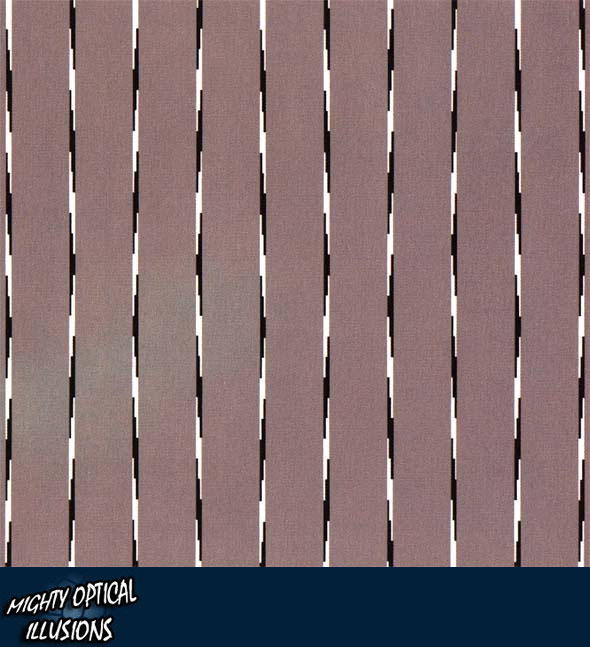
 Illusion created by Emily Knight and Arthur Shapiro
Illusion created by Emily Knight and Arthur Shapiro








 5 roasted sea laver sheets (nori in Japanese)
5 roasted sea laver sheets (nori in Japanese) Samgyopsal
Samgyopsal Oysters 8-10
Oysters 8-10 1 can of Gol Bang Ee (Sea shells)
1 can of Gol Bang Ee (Sea shells) Korea Rice Cake 2 Cups
Korea Rice Cake 2 Cups 1.5 LBs shank
1.5 LBs shank Chopped Kimchi 1/3 Cup
Chopped Kimchi 1/3 Cup




 1 LB of Korean Pancake Powder
1 LB of Korean Pancake Powder
 bean paste
bean paste red pepper paste
red pepper paste soy sauce
soy sauce sesame oil
sesame oil
